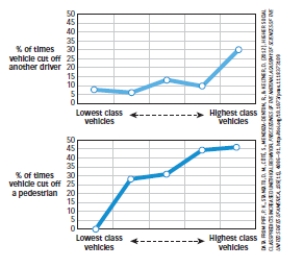Use the following to answer questions
Scenario I
Scenario I is based on and presents data from the following study (reproduced from p.25 of the textbook) :
Piff,P.K. ,Stancato,D.M. ,Côté,S. ,Mendoza-Denton,R. ,& Keltner,D.(2012) .Higher social class predicts increased unethical behavior.PNAS Proceedings of the National Academy of Sciences of the United States of America,109(11) ,4086-4091.doi:10.1073/pnas.1118373109
Piff and colleagues (2012) used naturalistic observation techniques to determine if wealthy people behaved more or less ethically than people who were not wealthy.In one study,observers stood at a busy intersection and recorded the make,model,and year of each approaching car.They also noted if the car cut off other cars or pedestrians at this intersection.
Major findings of Piff et al.(2012) are presented in Figure 1.1.This figure shows the percentage of times vehicles cut off another driver (top panel) or pedestrians (lower panel) as a function of the social status of the vehicles (with more expensive cars ranked higher in social status) .
Figure 1.1 
-(Scenario I) A psychologist believes that selfishness is a genetically based trait that confers advantages in terms of resource acquisition.As such,the psychologist is not surprised in the least that selfish people drive expensive cars.This _____ would predict that _____.
Definitions:
Differential Analysis
The process of comparing the costs and benefits of different business decisions or alternatives.
Markup Percentage
The percentage added to the cost of goods to cover overhead and profit, representing the difference between the cost of the product and its selling price.
Product Cost
The total of costs directly attributed to the production of a product, including materials, labor, and manufacturing overhead.
Contribution Margin
A metric that represents the amount of revenue from sales that exceeds the total variable costs associated with producing those sales.
Q1: Jean Piaget studied the perceptual and cognitive
Q5: Compensation systems are intended to do all
Q29: Wilhelm Wundt believed that consciousness could be
Q40: Which statement is TRUE about the scientific
Q111: Beginning in the 1950s,behaviorism began to receive
Q112: A synchronous pattern of variation between two
Q131: According to Chomsky,which observation of language in
Q181: Mike wants to know how many licks
Q222: Wundt believed that scientific psychology should focus
Q245: The early roots of psychology are firmly